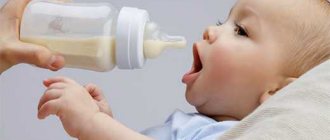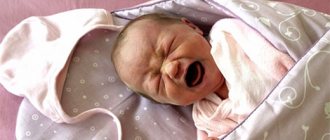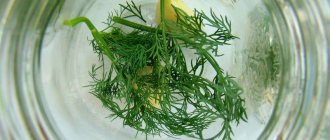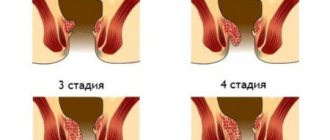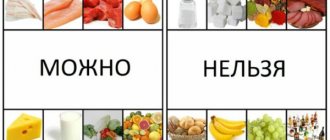What is intestinal colic?
Intestinal colic in children is pain that has a paroxysmal appearance. The cause of colic is increased gas production. In young children, gas accumulates in the intestines and is difficult to pass, resulting in pain and causing restlessness and crying in the child. Such difficulties with the passage of gases are explained by the fact that the gastrointestinal tract of newborn children is not fully formed. For nine months, while the baby was in the womb, his intestines did not have to work, and now, after the birth of the child, he will have to adapt to “earthly” life.
To determine that a child is suffering from intestinal colic, you need to take a close look at his behavior and note the characteristic symptoms. The child screams, pressing his legs to his tense stomach. Pain from colic bothers children at night and early in the morning. There is also the so-called “3x3” rule:
- Colic appears in the third week of life;
- Colic lasts about three hours;
- Colic goes away after three months.
Calling intestinal colic a disease is wrong, as is prescribing treatment. Rather, it is a physiological condition caused by intestinal maturation. It takes time for a set of necessary enzymes to form in the gastrointestinal tract and microflora to help digest food. The main role of parents at this stage is to help the child survive the first three difficult months, alleviating his suffering as much as possible.
Colic in a baby. What to do?
In order to help a newborn child survive the stage of pre-development of the gastrointestinal tract without pain, a number of measures should be taken. Conventionally, they can be divided into preventive and auxiliary. Preventive measures must be observed by all mothers, even if the child does not suffer from colic. Auxiliary measures are recommended to relieve abdominal pain.
- Diet for a nursing mother;
- Proper attachment of the baby to the breast;
- Using special bottles for artificial feeding;
- Placing the baby on his tummy before each feeding;
- Vertical position of the child after feeding until air burps.
A nursing mother most often limits herself to many foods while following a diet. But in order to prevent the occurrence of colic in a child, it is necessary to refuse all foods that cause increased gas formation. These are flour products, fresh fruits and vegetables, legumes. Fruits and vegetables can be replaced with stewed or boiled ones.
When putting your baby to the breast, you need to make sure that he takes it correctly, otherwise the baby will swallow air, which causes colic. The baby's mouth should be wide open, the lower lip should be turned out, and the nipple should be drawn into the baby's mouth. When feeding, the mother should not feel pain or hear smacking sounds. When artificial feeding, you should choose special bottles, the special structure of which prevents air bubbles from forming in the mixture and, accordingly, entering the baby’s stomach.
To prevent intestinal colic in newborns, the baby should be placed on his tummy before each feeding, even if he doesn’t really like it. A cheerful toy, a playful song or a nursery rhyme will help distract the baby. And at the end of feeding, you need to hold the baby in your arms in an upright position. You need to hold him in a “column” until he burps air.
Soothing warmth
Describing auxiliary measures, we will highlight several sections. One of the most popular is the use of heat. You can soothe your “broken” tummy with warmth in the following ways:
- Place the baby's tummy on the mother's chest;
- Apply a heating pad to your tummy;
- Apply a warm diaper to your tummy;
- Place a bag of cherry pits on your tummy.
Heat applied to the tummy has a fairly effective effect. Lying on mom's or dad's chest, the baby warms the tummy, which helps relieve pain from colic. And when he feels his loved one, as they say, on his skin, the child calms down. This brings additional positivity to this method.
There are other ways to warm your baby's tummy. For example, by applying a warm heating pad. Another way to eliminate colic in a baby is to apply a warm diaper. You can heat it on a radiator (in the cold season) or using an iron. Just before applying, make sure that the diaper is not too hot.
A positive “warmer” effect comes from using a linen bag with cherry pits, which is heated in the oven or microwave. You can sew such a bag yourself or purchase it in a store. Many companies produce toys made from linen material and stuffed with cherry pits. After the child grows up and there is no longer any need for such heating pads, they will turn into ordinary toys - funny chickens, kittens. And by sorting through the cherry pits that fill the toys, the child develops fine motor skills.
Exercises and massage
Special exercises, massage and other active methods can distract the child from pain, turning his attention to new objects. On the one hand, parents carry out an entertaining activity with the baby, on the other hand, they massage the tummy, helping the “gas” come out. However, these methods should not be practiced immediately after the child has eaten. Active ways to help with intestinal colic:
- Exercise: pulling the legs towards the stomach;
- Massage the tummy clockwise;
- Exercise on a gymnastic ball;
- Place on a pillow with the legs hanging down.
Place your baby on his back, grab his legs at the shins with your hands and gently press them towards your stomach. This exercise can be done by placing the baby on his tummy. Then the child takes a position similar to “all fours.” When performing this exercise, the muscles of the anus relax, and gases pass away more easily.
Massage your baby's tummy around the navel in a clockwise direction. To distract him from the pain, you can sing songs or recite nursery rhymes. Massage of the tummy also occurs when placing it on a gymnastic ball. Carefully place the child on the ball and, holding it with your hands, roll it. You can place the newborn on a pillow so that his legs hang down - his own weight will put pressure on the tummy and stimulate the release of gases.
Dill water for colic in newborns?
Is it possible for a newborn to use a heating pad?
The first year of a child's life is a special period of care in which parents, especially first-time parents, experience many doubts and worries.
First month: to sleep or not with parents? After four weeks at home, the child is still very dependent on the mother, and the mother, in turn, still feels very insecure about the child's reactions and needs, with every gesture, breath. But remember, it is important that this independence matures over time for both the child and the parents. Is breastfeeding necessary? baby drinks water from a bottle
Dill water is useful to drink not only for babies, but also for nursing mothers, as it improves lactation (milk flow) and reduces flatulence. It has a very repulsive, pungent odor, but if you try to mix it with breast milk or formula, the taste becomes acceptable.
Mom, your milk is the most complete and practical food that will be offered to a baby in the first year of life, containing all the nutrients necessary for the full development of the little one. For this reason, it should then be a priority unless maternal health does not allow adequate food production.
READ MORE: Which doctor should you go to if your leg hurts in your hip?
For infants who are breastfeeding, the introduction of other foods should begin at 6 months. The diet should be guided by a pediatrician, taking into account the amount of seasoning, salt and sugar appropriate for the child. For babies who are not breastfeeding, feeding natural snacks can begin as early as the fourth month.
First aid kit items
Sometimes the methods described above do not help, and the baby’s colic prevents him and all other family members from sleeping. You have to turn to pharmacies for help. This:
Various herbal preparations are widely and loudly advertised today. Their names are familiar to every modern mother. However, you should not mindlessly use what funny hippos and other characters offer on the TV screen. You should definitely consult your local pediatrician on this issue.
Dill water, as grandmothers call it, is an ancient remedy. To prepare it, you need to purchase dill or fennel seeds at the pharmacy. 1 teaspoon is poured into a glass of boiling water and left for half an hour. Then filter and cool. Give the baby dill water to drink several times a day, starting with a teaspoon.
A gas outlet tube is the most extreme measure. It should be in every mother's first aid kit, at least just in case. To use a gas tube, you need to insert it into the child's anus. The other end should be lowered into a container of water so that you can see whether the gases have escaped. The procedure lasts about five minutes.
Also read: Can nursing mothers eat borscht?
What really helped our children?
When my daughter started having colic and we started going crazy from her screams, we started looking for salvation on the Internet. On one of the forums they praised “Kuplaton”, we ordered it from Finland, they brought it to us and the problem disappeared.
Before our second child was born, we had already pre-booked him and again he helped us. There were no problems with colic at all. It is worth noting that this drug can only be purchased in online stores; it is not sold in regular pharmacies.
Harmful gases - get out!
Postpartum depression, constant lack of sleep, fatigue, mountains of diapers, hormonal changes in the body, strict diet, and then there’s the baby’s intestinal colic and constant crying! No matter how difficult the first three months are for you, during which intestinal colic appears, you need to patiently and systematically take measures to alleviate the child’s suffering, helping him free the intestines from gases. The positive emotional state of the mother affects the baby’s mood and helps him to endure intestinal pain more easily.
Various herbal preparations are widely and loudly advertised today. Their names are familiar to every modern mother. However, you should not mindlessly use what funny hippos and other characters offer on the TV screen. You should definitely consult your local pediatrician on this issue.
How to use a heating pad with cherry pits
The toy needs to be washed at thirty degrees, but the bag that is inside the heating pad cannot be washed. Shake it and ventilate it. You need to heat the bag of seeds in the microwave for several minutes at 600 W, or in the oven for eight to fifteen minutes at eighty degrees. Wait until the bag cools completely before reheating. Do not heat the toy completely. Cool the bag of seeds in the freezer by placing it in a plastic bag for 1 hour or 30 minutes. The toy heating pad with cherry pits is made of hypoallergenic materials.
Is it possible to put a heating pad on the stomach of a newborn with colic?
Every young mother is faced with the phenomenon of colic in her baby. They arise as a result of difficulty in passing gases from the intestines. The baby becomes restless, his sleep is disturbed, which negatively affects his overall well-being. That’s when mothers start thinking about how to relieve colic in their newborn baby.
What can be used to combat colic?
Today there are many medications that promote the rapid release of gas. The most common are Bebinos, Espumisan, Plantex. With the exception of the latter, these funds can be used from 1 month of life.
But what if a newborn baby is 2-3 weeks old and has colic, how can I help him? Then an old, proven way of fighting comes to the rescue - a heating pad, which our grandmothers used to treat colic in newborns.
How does a heating pad work for colic?
Heat applied to the baby's belly causes the gas bubbles in the intestines to burst and leave it. Also, instead of a heating pad, you can use a regular diaper, which just needs to be heated with an iron before use.
Recently, a salt heating pad has become very popular, which can also be used for colic. It is a sealed container containing reagents that, interacting with each other, generate heat.
How often can you use a heating pad?
A heating pad for colic can be used as many times as necessary. However, it is necessary to take into account the fact that the duration of warming should not exceed 5 minutes.
Preventing colic is the key to sound baby sleep
In order to prevent colic in the baby, the mother must follow a few simple rules:
- before feeding the baby, place it on the tummy for 3-4 minutes;
- during feeding, it is necessary to ensure that the baby grasps the breast correctly - this will prevent air from entering the stomach;
- After each feeding, hold the baby in an upright position until the air he has swallowed comes out.
How often can you use a heating pad?
A heating pad for colic in a newborn. What are the benefits of applying a heating pad?
How to deal with new teeth? Between the ages of 5 and 18 months, the first toes begin to fall off, so that a child who is smiling and playful may give way to a little crank and cry, because for many children, gum rupture is an annoying and even painful process. Parents and mothers can help with this phase by gently brushing the gums with their gauze-covered fingers or using numbing pomades.
How to dress a child without overheating or leaving him cold? A child's temperature is no different from that of an adult, but its resistance to climate change is more fragile. This means that in general the parents' sense of cold and warmth can be applied to dressing their children, however, there is always a change in clothing that allows adaptation in the event of a sudden change in temperature more or less. Additionally, sweat is a sign of excess clothing, and shivering, icy mothers and a need for warmth are indicators that the baby may be cold.
modern anti-colic heating pad
How does she help? It’s very simple: under the influence of heat, gas bubbles in the intestines burst and do not put pressure on the walls. Moreover, the abdominal muscles relax and do not put pressure on the intestines. A diaper heated with an iron has the same properties, the only difference is that it cools down faster than a heating pad.
The medicine is not recommended for a child without a doctor's prescription, even in repeated or seemingly common cases. Several symptoms of various diseases can confuse diagnoses, and medications, in addition to masking the disease, can create risks for the child. At the first sign of an abnormality, such as fever and pain beyond colic, it is important to consult your pediatrician.
What drugs and medicines help with colic and bloating in newborns?
The most important advice for new parents is to remain calm at this stage, which is a challenge, but one that will be better carried out and used as they become more serene in the process. Shall we meet here next week?
Anti-colic heating pad for newborns
Summary of the article
From birth, the newborn is surrounded by care and attention, which helps him quickly and painlessly adapt to the new world. However, this cannot always prevent the occurrence of such an unpleasant condition as colic. The most common means of combating them are a variety of medications, but not in all cases the newborn is allowed to give them. The problem of bloating can be solved by using a heating pad.
Warm heating pad for colicky babies
The advisability of a heating pad for colic is often questioned by inexperienced mothers, so the question often arises as to whether it is even possible to place a heating pad on the belly of a newborn. Pain relief from colic is one of the indications for using a warm heating pad. It relieves intestinal spasms, relaxes the abdominal muscles, pain is eliminated, and the baby feels relief. We must not forget that a heating pad for colic is not a panacea, so it may not help if you use it only. It is optimal if the heating pad is used in combination with other means and methods: massage, medications, dill water, etc.
At the same time, you should always remember that before using a heating pad, you need to make sure that the baby’s crying is caused by colic, so that in case of a serious reason you do not waste precious time. There are a number of symptoms that require immediate medical consultation.
- An attack of colic lasts more than 4 hours.
- The child's body temperature has increased.
- There are loose stools and diarrhea.
- Vomit.
- There are streaks of blood in the baby's stool, and the stool is greenish in color.
If one or more of the above symptoms occur, you should immediately call a doctor. In such cases, the use of a heating pad is strictly contraindicated.
Types of heating pads
There are many types of heating pads. The main difference between them is the type of filler that is used to retain heat. This could be water, saline solution, an electric heating element, cherry pits, etc. Based on the type of filler, the top material is selected, which should be safe, not cause allergic reactions and allow heat to pass through well. So, if there is still a need to use a heating pad for your baby, then stores and pharmacies offer the following range:
- water heating pad;
- electric heater;
- saline (salt) heating pad;
- dry heating pad (toy heating pad, cherry pit heating pad);
- gel heating pad.
All of these heating pads are reusable and can be used more than once.
Water heating pad (rubber, silicone)
It is a rubber or silicone container into which hot water is poured. The device has its pros and cons.
Advantages:
Flaws:
- it is difficult to control the temperature;
- If you use very hot water, you can burn your baby's skin;
- Pouring hot water can cause burns;
- the rubber heating pad cools down very quickly;
- from frequent use, the heating pad quickly cracks and becomes unusable.
Instructions for using a rubber heating pad.
- Heat the water to 60 C.
- Pour liquid into the heating pad to fill two-thirds of the container.
- Excess air is removed.
- The heating pad is tightly closed. Turn it over to check if water is leaking.
- The device is wrapped in a towel, diaper or placed in a special case.
Video on how to use a heating pad correctly
Salt heating pad
It is often called a salt warmer. It features uniform heating and gradual heat release. The supersaturated sodium acetate solution is contained in a sealed PVC package. When you press a button or stick inside the solution, a crystallization center is formed and heat begins to be released. Heating stops when crystallization is complete. By this time the heating pad will heat up to approximately 54 degrees. In the absence of contraindications, children can use a salt heating pad from birth.
Advantages:
- the design is sealed. The saline solution is non-toxic. This heating pad is completely safe for babies;
- the product does not cause allergies;
- acquires the desired shape for the area of the body;
- can be used instead of paraffin physiotherapy for dysplasia;
- This type of heating pad heats up quickly and stays warm for about three to four hours.
Flaws:
- If the packaging is damaged, the contents of the heating pad may leak.
Video of how a salt heating pad works
Electric heating pad
Electrical conductors are sewn into natural fabric. Temperature regulation is carried out using a thermostat. An appliance that does not have a thermostat may burn your skin.
Advantages:
- The thermostat allows you to quickly set the desired temperature;
- heat flows uninterruptedly.
Flaws:
- the electric heating pad takes about 7 minutes to heat up;
- the device is not mobile;
- the price of the product is high.
Important! An electric heating pad can be used to warm a crib or stroller. But you can’t put it on a baby’s body. Getting rid of colic is only possible if you apply a diaper heated from a heating pad to the baby's tummy.
Dry heating pad (toy heating pad, cherry pit heating pad)
The toy heating pad and the cherry pit heating pad are dry types of heating pads, as they use dry filling and the top is made of fabric (linen or cotton). This heating pad is activated from any heat source: microwave, oven, battery. Cherry pits emit a pleasant smell when heated, making them perfect for aromatherapy. Instead of cherry pits, it can be any suitable material that heats up quickly but releases heat for a long time: rice, peas, table salt, etc.
Important! When choosing a dry heating pad, make sure that the filler is placed in a separate bag. This design is very convenient when washing - you can remove the inner bag and wash the upper one.
Most often it comes in the form of a soft toy, and it can be either a fairly small heating pad or a large one. Using a heating pad with natural filling is safe for the baby’s health. Hot-water bottle toys with cherry pits ZerO-99 and thermo-toys “Doctor Myakish” are popular among young parents.
Also read: At what months can you start feeding your baby?
Advantages:
- ease of use and time saving;
- the ability to choose any size and design;
- the heating pad takes on the shape of the body;
- 100% natural;
- there is no possibility of getting burned, even if the fabric is torn;
- you can make a toy heating pad yourself;
- a cooled device can be used as a toy. With its help, a six-month-old baby develops fine motor skills.
Flaws:
- when heated, the natural filler releases an odor that may not always be to your liking;
- The service life of a soft heating pad with filling is short;
- If the device does not have a removable top, only dry cleaning is recommended.
Find out the price and buy a heating pad in the Obstetrics online store
Instructions for using a heating pad filled with cherry pits.
- Place a heating pad in the microwave for 1 minute. In this case, a power of 600 W is selected. You can put it in the oven for 10 - 15 minutes, setting the temperature to 80 degrees.
- The heated bag is inserted into a soft toy and applied to the baby’s tummy for five minutes.
Warming gel heating pad (heating belt)
It is often called a “happy tummy” or a gel-filled heating pad. Thanks to the thermal procedure, the gas comes out easily, and the pain in the tummy area is relieved. The size is adjustable using Velcro on the belt.
How to use the anti-colic gel heating pad:
- The gel battery is placed in a plastic container with water so that the water completely covers the contents.
- Place the container with water in the microwave for 30 – 90 seconds (depending on power). The temperature of the heating pad for a newborn should reach 50 C, but not higher than 60 C. If warming up takes a long time, pause for 15 seconds.
- You can warm up the battery with boiling water. To do this, pour boiling water over the gel element and leave for 3–4 minutes. Then take it out and blot it with a towel. The battery should be heated to a comfortable temperature. If it is hot, you need to let it cool.
- The battery is inserted into the belt, the heating belt is attached to the baby's tummy.
Possible applications
Heat exchange in newborn babies is not yet fully formed, the ability to thermoregulate is absent, which means the risk of hypothermia or overheating of the little one increases greatly.
Any parent worries that the child does not feel cold, otherwise he may get sick. When will the heating pad help us out? In slushy and rainy weather, a warm assistant will come in handy during walks. Put him in the stroller and enjoy your walk.
For illnesses
Often, the thermal operation of a compact heater is appropriate in the treatment of certain diseases. It helps relieve pain and creates a relaxing and calming effect. Please note an important thing - all thermal procedures during illnesses can only be used after consultation with a doctor. Do not self-medicate, consult a specialist.
Thermal procedures for illnesses are not always appropriate, so you need to first consult with a doctor.
A heating pad for a newborn against colic becomes a salvation for many parents who are nervous, do not get enough sleep from the constant crying of the child, and cannot calm him down or stop the screaming.
The baby is born with not fully formed organs. In the first days after birth, the intestines are not able to fight microbes that are sent with mother's milk or nutritional formulas. When this microflora multiplies, gases appear. They stretch the baby’s intestinal walls, and he suffers from pain.
Cramps sometimes occur when the baby swallows air or sucks very hard at the breast. To prevent this from happening, it must be applied correctly, after finishing feeding, hold it vertically. Colic torments the baby from 2 weeks of age and makes itself felt:
- prolonged screaming;
- bending of legs;
- release of gases.
After a few months, the intestines begin to function normally. To prevent the child from suffering all this time, doctors advise using heat.
How to relieve pain?
Parents find different ways to help relieve colic. You can put a diaper on the tummy, but it cools down quickly, and you can give the baby medicine, but this is harmful to health. The child calms down when he is carried in a sling, because he smells milk, and his mother is nearby. But it’s hard for a woman to do this all the time.
A warm compress with oil reduces pain, but if the liquid leaks out, it will burn the delicate skin near the navel. Bathing before bed excites the newborn, and the baby does not calm down for a long time and cannot fall asleep.
It is more convenient to use a heating pad. Such products are produced by many well-known companies with different fillers. When applying them:
- Blood circulation accelerates.
- The spasm passes.
- The abdominal muscles relax.
- Pain is reduced.
A special effect is achieved if the heating pad is combined with a massage using dill water. When choosing a design, preference should be given to the product in which the filler is in a separate bag.
Instead of using a heating pad, you need to call a pediatrician to see your child:
- at high temperature;
- with vomiting and diarrhea;
- with streaks of blood in the stool.
Heat is contraindicated for colic that lasts for hours, inflammation in the peritoneum, or an open wound on the body. Doctors do not recommend using the products on children prone to allergies or suffering from dermatitis.
The structures used to retain heat differ in their filler. A solution of salt, berry seeds, and gel are placed in them. The heating pad is placed not only on the umbilical area of the newborn, but also in the crib so that the baby feels comfortable. The material in which the filler is packaged does not contain synthetic components and does not cause allergies.
The cheapest rubber or silicone heating pads are filled with water at 60 degrees, leaving a third of the container unfilled. After this, the accumulated air is released, the lid is screwed on tightly and turned over to check if the liquid is dripping.
In an electric heating pad, you can change the temperature. Such products are made from fabric into which current conductors are sewn, thanks to which the heat is maintained constantly. The device is connected to the network, it costs much more than a rubber design. The product is convenient for heating a crib or stroller, but you only need to apply a warm diaper to the body, and not the device itself.
Sealed heating pads
The brine solution, which is prepared from sodium acetate, is sealed in polyvinyl chloride packaging. If you press the button of such a heating pad, a reaction occurs; the liquid begins to crystallize, releasing heat.
The advantages of this design include:
- excellent tightness;
- hypoallergenic;
- safety.
The heating pad is easy to give the desired shape, the heat does not disappear for 4 hours, and the temperature of the solution quickly heats up. It is sometimes used instead of physiotherapeutic paraffin manipulations.
The design is intended for repeated use. After use, it is wrapped in material and immersed in boiling water for about 15 minutes. The solution will take on a liquid form. In order for the salt heating pad to serve for a long time, you need to follow simple rules:
- Do not place in microwave oven.
- Do not bend or pierce in boiling water.
- Protect from impacts.
The product must be placed in hot water, wrapped in cloth. It is used not only to combat spasms, it is recommended to apply it to the nose, legs or ears.
In addition to a salt heating pad, a gel belt is great for newborns against colic. Before placing it on the baby’s tummy, the battery is heated in a container with water to 50 degrees and inserted into a special hole in the belt.
Dry heating pads
As a filler for products that help remove accumulated gases from the baby, not only water or gel is used, but also salt, peas, cherry or cherry pits, and barley husks. The bags are made of cotton or linen.
The heat source for such a heating pad is any device. These products are produced in the form of toys, differing in size and shape. Parents praise the Honey Mammy, Zer 099, and Doctor Myakish models.
The advantages of dry fillers include:
- safety;
- pleasant aroma;
- no synthetics or chemicals.
The heating pad can change shape and you cannot get burned on it. The product applied to the tummy calms the child, and he stops screaming and falls asleep.
Before use, take out the bag with the filler and put it in the microwave for a quarter of an hour, set the power to about 600 W. Sometimes women use an oven at 80 degrees to heat it up, and then insert the bag into the toy.
If you read reviews from parents of infants, it becomes clear that many people like the heating pad with bones the most. The grown-up baby plays with it, developing muscles and hand motor skills.
It is convenient to use salt products that do not pose a danger to the newborn, do not cause skin irritation, and last a long time.
Some women prefer a gel belt. It is attached with Velcro, retains heat for a long time, and is adjustable in size.
If you don’t have a heating pad at hand, and the baby is screaming in pain, you need to pour hot water into a plastic bottle, wrap it several times in a cloth, and apply it to the tummy. The temperature of the liquid should not exceed 60 degrees.
It’s easy to sew a bag of thick material and pour heated salt into it. Warmth will ease the baby's condition.
Newborn babies cause trouble for parents because they often cry and scream. The reason for this behavior is the accumulation of gases in the intestines, which leads to severe pain. If the baby does not have a fever or diarrhea, colic is relieved by applying a warm heating pad to the tummy.
Colic occurs in many newborns, and there are many reasons for the formation of gas in the intestines. It is not so important to establish the cause as to relieve the child of unpleasant sensations. A heating pad on the tummy of a newborn with colic is an effective method of eliminating pain and bloating without taking medications. In this regard, it is important to know what types of heating pads are available and how to use them correctly.
A warm heating pad will help solve the problem of colic without the use of medications.
If the mother takes precautions, selects the right temperature and observes the child’s reaction, then she cannot do any harm.
It is worth remembering that heating the abdominal cavity is carried out only in the absence of foreign signs of disease or allergic rashes on the skin.
Contraindications are:
- Increased body temperature. By applying a warm heating pad to the child's body, a young mother can only aggravate his condition. The temperature will rise. This can be dangerous to the life and health of a child, especially a newborn under 1 month of age.
- Presence of injuries in the abdominal area. Heat can trigger the development of purulent formations.
It is prohibited to use a heating pad if the baby has a high temperature.
- Diseases of the abdominal cavity and gastrointestinal tract. The mother must be sure that her child is suffering from colic, and not a gastrointestinal disorder. Diarrhea or constipation, poisoning or other diseases cannot be treated with warm heating pads. And their use can aggravate current bowel abnormalities.
- Inflammation of any organs. Inflammation from heat begins to develop even more severely, and the affected areas become larger.
READ MORE: Pain in the shoulder joint of the left arm: what to treat, which doctor
? Modern devices are not necessarily filled with water. A heating pad for a newborn against colic with cherry pits is actively used by young mothers. The range of devices is varied both in appearance and in the composition of the filler.
A heating pad is especially convenient for a newborn.
Before purchasing a heating pad, it is recommended that you familiarize yourself with the recommendations for using this device:
- before use, you need to moisturize the child’s skin with cream or milk; this measure will help avoid drying out the skin and the appearance of redness and irritation;
- if a child has a cold, a heating pad can only be applied during the recovery stage, otherwise dry heat can cause the disease to progress;
- before applying the heating pad, you need to wrap it in a clean diaper or towel;
- if the product has a cover, it is important to regularly clean or wash it;
- You can make a simple heating pad yourself; to do this, just sew a bag of natural fabric into which you place dried cherry pits or table salt. Before use, such a product must be heated in a microwave oven, carefully choosing the temperature;
- Before using a heating pad, it is important to consult a specialist. Against the background of a number of diseases, the use of dry heat is unacceptable.
Which heating pad is better?
According to user reviews, the design with cherry pits is considered the best heating pad. Infants from 5 to 6 months are given it as a toy. The child can play with it, developing fine motor skills. A heating pad with natural filling can be used to warm a baby's crib before bedtime.
In second place in popularity is the salt heating pad. It is absolutely safe, easy to use, durable.
The warming gel heating pad also demonstrates a wonderful effect. It has a number of advantages (ease of use, efficiency, durability). The disadvantages include high cost.
Thus, all types of heating pads, with the exception of electric ones, can be used against colic when applied to a newborn’s tummy.
Video of a DIY heating toy
How to make a heating pad at home or how to replace it
If you don’t have a heating pad, you can relieve the spasm in your tummy using one of the following methods.
- Water is poured into a 0.5 liter plastic bottle at a temperature of 60 C. The container is tightly closed. The bottle is wrapped in several layers of fabric and applied to the tummy for 5 - 6 minutes.
- Sew a bag from thick natural fabric. The salt is heated in a frying pan, without adding oil, to a temperature of 60 C. Pour the salt inside the bag and tie it tightly. Wrap the structure in a towel. A homemade heating pad is applied to the baby’s tummy for 5-6 minutes.
- They sew a cover from multi-colored plush in the form of a soft toy. Separately, a bag is prepared from thick fabric. Cherry pits are washed well and dried. Filling is poured into a fabric bag and sewn up. Before use, place the bag of cherry pits in the microwave or oven. The bones are heated to 55 C, placed in a toy and applied to the tummy for 5 minutes.
It is a rubber or silicone container into which hot water is poured. The device has its pros and cons.
Types of heating pads, their pros and cons, application
As mentioned above, there are several types of heating pads:
- Salt or salt heating pad. It has two main advantages: it is produced in the form of funny toys and is the safest heating pad. It is a toy made of high-quality, strong and reliable PVC material. Contains a highly concentrated saline solution inside. When a special mechanism is started inside, the crystallization process begins inside, due to which heat is released. Maximum heating does not exceed 54 degrees. Heating occurs in 10 minutes. The heat is retained for 4–5 hours. Convenient to take with you on a trip or visit. Doesn't take up much space in mom's handbag.
- Warmer pillow. Produced from natural materials. Externally it has a toy shape that is pleasing to a child's eye. Contains natural filling inside: buckwheat, cherry pit or herbs (chamomile or lavender). Serves not only to relieve pain, but also has a calming effect when infused with herbs. Parents should be careful with lavender filling. Due to the pungent odor, it can have the opposite effect and overstimulate the child.
- Gel heating pad. The heating process follows the same principle as salt. Only in this case there is a safe hypoallergenic gel inside. This gel is also used in teethers. The solution is heated to a maximum of 60 degrees. It maintains this temperature near the beginning, then slowly cools down. The heating pad can be both heated and cooled (for example, for bruises).
- Electric. This option is considered unsafe for use with small children. The device has the ability to sharply change the temperature upward.
- Rubber. This option is not recommended by modern pediatricians for use with infants. The device is heavy and large. With regular use, small cracks appear, which subsequently lead to leakage of hot water. In rare cases, heating pads can explode due to temperature changes.
We recommend: Atopic dermatitis in children
Is it possible for a newborn to use a heating pad?
One of the most proven ways to eliminate bloating in the tummy in infants is to use dry heat. Namely, apply a heating pad to your stomach . Experts also recommend using a heating pad, but this may not always help the baby.
Let's consider all the main ways to combat this disease:
- It is recommended to massage the abdominal area clockwise;
- You can heat the cotton films with an iron and place them on the baby’s stomach;
- Use different types of heating pads;
- Use a sling.
But, as practice shows, children are all different. For some, a device such as a heating pad for a newborn against colic is , but for others, other methods also help.
Salt heating pad for newborns against colic
This type of heating pad is a package that is hermetically sealed, and inside it there is a solution of salt of chemical origin. For infants, this salt will not harm in any way. There is a special button inside the package that starts the heating process. After complete heating, the dry heating pad begins to become harder, and this happens until it cools down completely.
Warming up such a heating pad for a newborn from colic occurs no higher than fifty-four degrees. This is a normal temperature for a small child. When using a salt heating pad, the baby will not receive various burns or skin irritations. It is best to use it by first wrapping it in a flannel diaper or terry towel. Cooling occurs after four hours, unlike conventional rubber types.
As soon as you have finished using the heating pad, you need to boil it in hot water for about ten minutes, and you can use it again.
Warmer for newborns with cherry pits
This baby heating pad is an excellent and convenient tool, not only for the mother, but also for the child. This type is mainly made in the form of toys, the filler of which is cherry pits. They have a beneficial effect on a small child, while providing a healing effect. These toys can be used in 3 options - hot, neutral and cold.
On store shelves you can see them in the form of various animals or little people, made from materials that do not cause an allergic reaction. If your baby has tummy problems, then a colic heating pad for a newborn with cherry pits will solve them. To do this, heat it in the microwave at a power of 600 W and apply it to the baby’s tummy. After some time, the baby calms down. If the toy has cooled down, you can warm it up again if necessary. This heating pad is also the best sedative.
Washing should be done on the most gentle cycle, preferably on a delicate cycle. But, under no circumstances wash the filler itself. It must be shaken and ventilated. Cool this toy in the freezer for about an hour.
Also read: How to calculate fertile days online
Hot water bottle toy for newborns
To sew such warmers, they use cotton or linen material, or plush, but the filling can be different. Let's look at some of them:
- The toy is a heating pad with various grains or legumes. Mostly millet or wheat is used, but it happens that manufacturers add buckwheat with rice, or peas.
- Hot water bottle for colic with cherry pits. It retains heat for a long time, allows the child to play and get new sensations from contact with the bones, which additionally also have a massage effect.
- Toy with lavender filling . It has a calming effect. Has a beneficial effect on baby's sleep.
- Toys with mint and other various aromatic fillings, which are often used in aromatherapy.
A heating pad for a newborn against colic can have any type and filling.
Gel heating pad for newborns
Also, in stores and pharmacies you can see a heating pad with peat gel, or gel. This is the most environmentally friendly filler. In addition to it, manufacturers can add various cereals, cherry pits or aromatic herbs. This tummy warmer is a simple cotton bag that is heated in a microwave or oven. Just two minutes will be enough, but it keeps the heat for 60 minutes.
This heating pad for a newborn against colic is safe to use, and in addition it also emits a pleasant aroma. There are also disadvantages to this type of heat - it is not suitable for long-term use and cannot be washed.
It is better to purchase such products in pharmacies, where it is recommended to immediately check the integrity of the packaging. Do not forget that when using for a baby, it is best to place the heating pad on any fabric. Otherwise, the baby may get burns.
Electric heating pad for newborns
An electric heating pad is a fabric device into which special heating elements are sewn. Heating occurs by connecting such a device to the network, that is, to an outlet.
It is better to buy a device that allows you to regulate the temperature itself. This is necessary so that in the future the warm heating pad does not overheat too much, or, conversely, does not become cold. The advantage of this type is temperature control, but the disadvantage is that it will not work without a network.
It should also be noted that such a heating pad for a newborn against colic is not cheap. The cost of such equipment ranges from one thousand rubles, depending on the manufacturer. It can also be used to heat a child’s bed before the child goes to bed.
Instructions on how to place a heating pad on a newborn's tummy
Any heat applied to the baby's belly helps him get rid of intestinal colic . But not all parents know how to apply such things correctly. Let's look at the basic instructions.
How to use a heating pad and how often? Answering the question posed, we can say the following - we use as many times as necessary. But, the heating time of the tummy should not exceed five minutes. Be sure to wrap it in any fabric or towel first.
What temperature should the heating pad be ? Answer: warm, but in no case hot, otherwise burns and various redness may occur. You can make sure that the temperature of the heating pad is optimal in the following way: just apply it to your stomach, and if you do not experience any discomfort, then you can place it on your baby’s tummy.
Why a heating pad is dangerous for a newborn Dr. Komarovsky video
In order for colic to torment your baby less, you must follow the most basic rules:
- Before you start feeding, place the baby on a hard surface on his stomach. Three minutes will be enough;
- Proper feeding of the baby. To do this, watch how the baby grasps the mother's breast. During feeding, as little air as possible should enter through the mouth;
- After feeding the baby, it is recommended to hold him in an upright position until a burp occurs and the air that got in with the breast milk comes out.
Each parent wants only good things for their child. The main thing is not to overdo it in the question of what a heating pad for a newborn should be for colic. It should not have a harmful effect on the baby. It should help solve the problem, but not the other way around. Therefore, approach everything wisely, and it is better to consult with specialists before taking any action.
It should also be noted that such a heating pad for a newborn against colic is not cheap. The cost of such equipment ranges from one thousand rubles, depending on the manufacturer. It can also be used to heat a child’s bed before the child goes to bed.
Massage for colic in a newborn video
Types of heating pads for newborns
How to determine the cause of screaming?
A baby's cry is usually a mystery and a challenge for parents, and can, among other things, indicate hunger, heat, cramps or dirty diapers. However, over time, parents begin to identify some specific characteristics of each cry, for example, when the child writhes more in his body - as a sign of sleep, and so on. In all these situations, parents or caregivers must remain calm as their anxiety also interferes with the development of minor crying. How should children's hygiene be? A daily bath is important to remove residual sweat, urine, feces and vomit. On hot days, or even when the child is very fussy, other baths may be given, not just for cleansing, but as relaxing ones. Exchanging fecal diapers should be done immediately, avoiding rashes and risks of urinary tract infections, since beer diapers should be exchanged before the moisture in the urine comes into contact with the baby's skin.
clockwise massage
Before you start the massage, you need to warm up your tummy. This will allow your abdominal muscles to relax. To do this, iron the diaper with a hot iron without the “steam” setting and fold it several times. A warm but not scalding diaper is applied to the baby's tummy until it cools down.
Do not press the diaper too tightly to the tummy with your palms so that the baby does not throw it off. You can pat his tummy over the fabric. It is also recommended to raise the baby’s legs or press them with your knees to the tummy. so he can fart easier.
Due to the adaptation phase of the baby's body and senses to the outside world, as well as his low immunity to microorganisms such as viruses and bacteria, it is ideal that the baby does not leave the house until the first month of life and has limited visits during this period. The idea is not to put the child in a glass jar, but to gradually adapt his contact with this new world.
Infants younger than six months should not wear sunscreen or repellent because their bodies are not yet mature to deal with the chemical components of the formula. However, sunbathing is recommended, but only if parents and guardians keep the exposure time to no more than 10 minutes, before 10 hours and after 4 hours, in children aged 2 months and above. For mosquito prevention, dressing young children in long sleeves and panties helps prevent bites, and after six months, food choices should be guided by a pediatrician.
pressing the legs to the tummy
How to perform a massage:
- Cup your palms with your fingers interlocked. This “house” needs to be lowered onto the baby’s tummy in the navel area. Apply light strokes to the tummy in a clockwise direction. Be careful, you should press hard on the right side, where the baby’s liver is located.
- Move your palms to the right and left at the level of the navel, it is in this part of the intestines that gases accumulate
- Place two palms on the baby’s stomach parallel to each other, with stroking movements, direct your hands in different directions: down and up
- You can try to move your hands in the shape of the letter “P”, which will also help remove gases from the intestines naturally
- When performing circular movements, try to do them with increasing force and in no case put too much pressure on your stomach
- It is useful to place the baby on his tummy, this helps him release excess gas from the intestines

